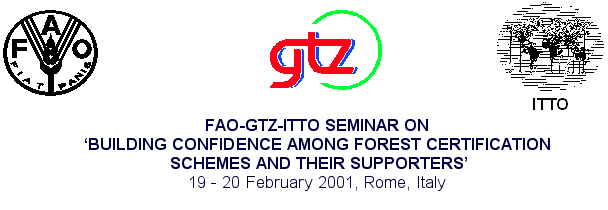Critical elements for forest certification schemes
Critical elements for the assessment of schemes:
Establishing comparability and equivalence amongst forest management
certification schemes was written by Peter Kanowski,
Darren Sinclair, Blair Freeman and Stephen Bass.
Mike Ryan
Forest Industries
Agriculture, Fisheries and Forestry - Australia |
Introduction
·
Proliferation of schemes
· comparability and equivalence
· proposed critical
elements
· some issues
that were dropped |
proliferation of schemes
· potential costs and benefits |
Comparability and
equivalence
· range of approaches possible
- unorganised adjustment
- unilateral,
bilateral, multilateral and universal recognition |
Proposed critical elements
· Reviewed ten comparability and equivalence related initiatives
· analysis of themes in three broad categories
· proposes eight critical elements for establishing comparability and
equivalence |
Proposed critical
elements
|
Accordance
· Certification should be consistent with internationally accepted
principles of sustainable forest management, comply with any national and
international policies, regulations and obligations which directly relate
to sustainable forest management, and contain measurable performance
standards (both quantitative and qualitative) that give effect to these
requirements
- Recognises the complementary nature of forest certification, to
national and international frameworks |
Access
· Certification standards, principles and criteria must accommodate
all forest types and ownership and operational structures
|
Participation
· In general, participation should be fostered. However, the level
of participation should be appropriate to the particular stage of the
certification process, with broad stakeholder involvement during
establishment and dispute resolution stages, and narrower representation
during accreditation and certification stages
- attempts to accommodate tensions between process and outcome
oriented approaches to participation
- recognises political nature of standard setting
processes |
Accreditation
· The accreditation of certification bodies should be consistent
with internationally accepted methods of assessment and selection, for
example
ISO/IEC Guide 61:1996
|
Transparency
· All stages of the certification process should be transparent.
This includes the development of certification standards, criteria and
principles, the operations of accreditation and certification bodies, and
the non-commercial results of certification, in forms that are accessible
and meaningful
|
Independence
· A clear separation of processes (but not necessarily of
institutions) shall exist between: establishing criteria and indicators;
accreditation of certification bodies; and dispute settlement.
Certification must be carried out by independent, third party bodies that
are free from both commercial and policy conflicts of interest
- again central to credibility
- needs to be as comprehensive as possible and not enough to exclude
only those with a commercial interest, but should be extended to those
with a policy/advocacy interest |
Consistency
· Both qualitative and quantitative standards and certification
procedures, should be clear, and easily understood, assessed and recorded.
Standards and procedures should provide reliable and consistent
information, so that the certification process should lead to the same
result from different auditors
|
Continuous improvement
· To foster continuous improvement in sustainable forest management
and certification processes, standards and procedures should be adaptive
and regularly revised so that they may respond to new knowledge and
changing demands |
Chain of custody and product
labelling
· Chain of custody procedures must be transparent, robust and
verifiable by independent parties. The claims made by product labels
should be clear and transparent. In the absence of mutual recognition and
an agreed label, labels should clearly distinguish alternate certification
schemes
|
Some issues that were
dropped
· Cost-effectiveness
· Conditionality
|
Assessing existing initiatives
and schemes
· preliminary assessment found general agreement
|



